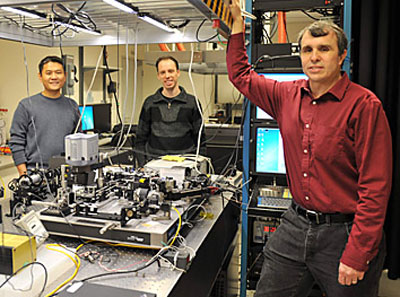 A new microscope invented by scientists at Howard Hughes Medical Institute's Janelia Farm Research Campus will let researchers use an exquisitely thin sheet of light -- similar to that used in supermarket bar-code scanners -- to peer inside single living cells, revealing the three-dimensional shapes of cellular landmarks in unprecedented detail. The microscopy technique images at high speed, so researchers can create dazzling movies that make biological processes, such as cell division, come alive.
A new microscope invented by scientists at Howard Hughes Medical Institute's Janelia Farm Research Campus will let researchers use an exquisitely thin sheet of light -- similar to that used in supermarket bar-code scanners -- to peer inside single living cells, revealing the three-dimensional shapes of cellular landmarks in unprecedented detail. The microscopy technique images at high speed, so researchers can create dazzling movies that make biological processes, such as cell division, come alive.
Mar 4th, 2011
Read more
The ONAMI Safer Nanomaterials and Nanomanufacturing Initiative's (SNNI) 6th annual Greener Nano Conference (GN11) - Advancing Applications and Reducing Risk - will be hosted by Hewlett-Packard Company at its Cupertino, CA site on May 1-3, 2011.
Mar 4th, 2011
Read more
The latest from the Periodic Table of Elements team
Mar 4th, 2011
Read more
A research team was able to show details with dimensions of just 5 to 6 angstroems, which are nearly atomic orders of magnitude.
Mar 4th, 2011
Read more
European Schoolnet is launching a new call for teachers across Europe, to participate in the project NANOCHANNELS which just started in January 2011 and is funded under the 7th Framework Programme from Directorate-General Research.
Mar 4th, 2011
Read more
Doctor Idurre Kaltzakorta introduced capsules filled with organic material into the cement, in a PhD thesis undertaken at Tecnalia and defended at the University of the Basque Country.
Mar 4th, 2011
Read more
Researchers from CNRS and the Universite de Bordeaux, in collaboration with a Chinese team, have developed the first molecular piston capable of self-assembly. Their research represents a significant technological advance in the design of molecular motors. Such pistons could, for example, be used to manufacture artificial muscles or create polymers with controllable stiffness.
Mar 4th, 2011
Read more
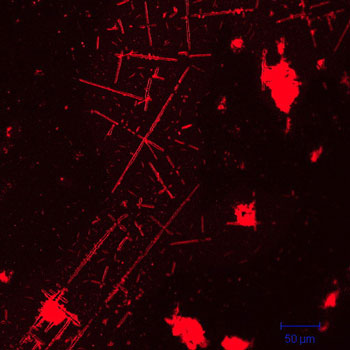 Materialwissenschaftler der Uni Jena erschaffen neues biophotonisches Hybridmaterial.
Materialwissenschaftler der Uni Jena erschaffen neues biophotonisches Hybridmaterial.
Mar 4th, 2011
Read more
 Similar patterned surfaces are currently made using complex and expensive photolithography methods and etch processes under clean room conditions and used in the fabrication of many optical, electrical, and mechanical devices.
Similar patterned surfaces are currently made using complex and expensive photolithography methods and etch processes under clean room conditions and used in the fabrication of many optical, electrical, and mechanical devices.
Mar 4th, 2011
Read more
In recent years, quantum computers have lost some of their lustre. However, a new quantum algorithm, which shows how a quantum computer could be used to simulate a complex system of interacting particles, raises hopes that some of the barriers blocking the wider application of quantum computing could soon be solved.
Mar 4th, 2011
Read more
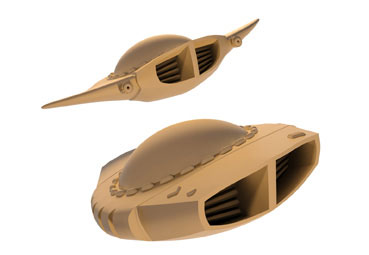 Ein visionaeres Entwicklungsprojekt der Hochschule Karlsruhe wird ab Maerz 2011 im Ars Electronica Center vorgestellt: Teil der neuen, gross angelegten Praesentation ist auch das Projekt "Nautilos". Das Mini-U-Boot "Nautilos" soll zur Krebstherapie in der menschlichen Blutbahn eingesetzt werden und mit optischen Methoden nahezu permanent das Blut seines Traegers untersuchen.
Ein visionaeres Entwicklungsprojekt der Hochschule Karlsruhe wird ab Maerz 2011 im Ars Electronica Center vorgestellt: Teil der neuen, gross angelegten Praesentation ist auch das Projekt "Nautilos". Das Mini-U-Boot "Nautilos" soll zur Krebstherapie in der menschlichen Blutbahn eingesetzt werden und mit optischen Methoden nahezu permanent das Blut seines Traegers untersuchen.
Mar 4th, 2011
Read more
The Rice lab of chemist James Tour reported this week in the journal Science that sputtering zinc onto multilayered graphene enabled the team to remove a single layer at a time without disturbing the layers beneath.
Mar 4th, 2011
Read more
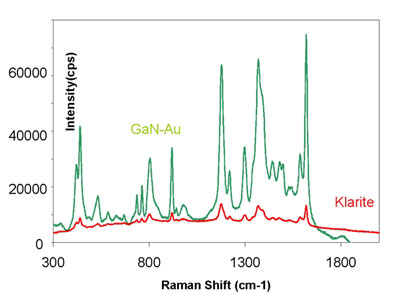 Gold-coated substrates of gallium nitride with specifically formed surface, developed by researchers from the Institute of Physical Chemistry of the Polish Academy of Sciences and the Institute of High Pressure Physics of the PAS display worldwide unique properties. Thanks to these new substrates, an extremely sensitive SERS analytical technique, capable of detecting even single molecules, after decades of waiting in specialized laboratories has finally got a chance to widespread and revolutionize medical diagnostics.
Gold-coated substrates of gallium nitride with specifically formed surface, developed by researchers from the Institute of Physical Chemistry of the Polish Academy of Sciences and the Institute of High Pressure Physics of the PAS display worldwide unique properties. Thanks to these new substrates, an extremely sensitive SERS analytical technique, capable of detecting even single molecules, after decades of waiting in specialized laboratories has finally got a chance to widespread and revolutionize medical diagnostics.
Mar 4th, 2011
Read more
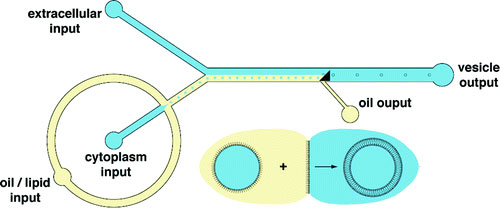 Borrowing a page from modern manufacturing, scientists from the Florida campus of The Scripps Research Institute have built a microscopic assembly line that mass produces synthetic cell-like compartments.
Borrowing a page from modern manufacturing, scientists from the Florida campus of The Scripps Research Institute have built a microscopic assembly line that mass produces synthetic cell-like compartments.
Mar 4th, 2011
Read more
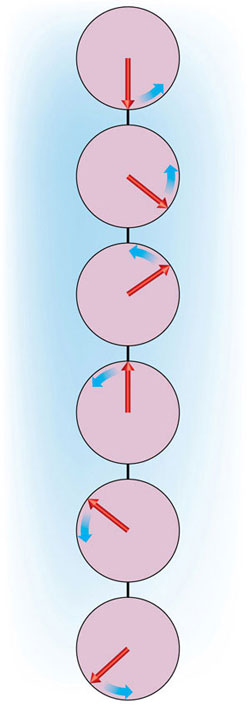 Calculations can now predict when and how spins of electrons and ions arrange in one-dimensional multiferroic materials.
Calculations can now predict when and how spins of electrons and ions arrange in one-dimensional multiferroic materials.
Mar 4th, 2011
Read more
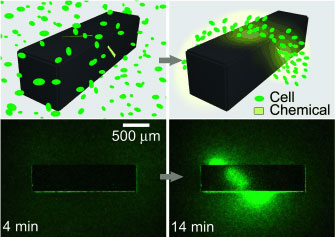 To find our way, we use maps. Cells use "chemical maps" to find the way: they orient themselves by following concentration gradients of attractants or repellants. David H. Gracias and a team at Johns Hopkins University (Baltimore, USA) have now developed a clever new method to produce three-dimensional patterns of chemical concentration gradients in vitro - with previously unattainable versatility and precision in both space and time.
To find our way, we use maps. Cells use "chemical maps" to find the way: they orient themselves by following concentration gradients of attractants or repellants. David H. Gracias and a team at Johns Hopkins University (Baltimore, USA) have now developed a clever new method to produce three-dimensional patterns of chemical concentration gradients in vitro - with previously unattainable versatility and precision in both space and time.
Mar 3rd, 2011
Read more
 A new microscope invented by scientists at Howard Hughes Medical Institute's Janelia Farm Research Campus will let researchers use an exquisitely thin sheet of light -- similar to that used in supermarket bar-code scanners -- to peer inside single living cells, revealing the three-dimensional shapes of cellular landmarks in unprecedented detail. The microscopy technique images at high speed, so researchers can create dazzling movies that make biological processes, such as cell division, come alive.
A new microscope invented by scientists at Howard Hughes Medical Institute's Janelia Farm Research Campus will let researchers use an exquisitely thin sheet of light -- similar to that used in supermarket bar-code scanners -- to peer inside single living cells, revealing the three-dimensional shapes of cellular landmarks in unprecedented detail. The microscopy technique images at high speed, so researchers can create dazzling movies that make biological processes, such as cell division, come alive. 







 Subscribe to our Nanotechnology News feed
Subscribe to our Nanotechnology News feed